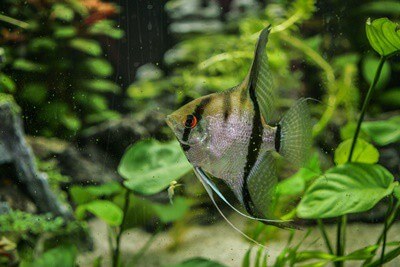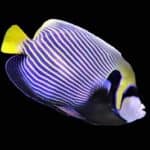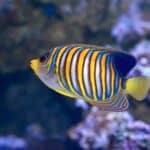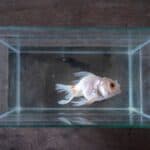Angelfish are among the most beautiful reef fish due to their elegant shape and diverse colors. That said, an angelfish’s form and behavior have more to do with survival than cosmetics.
From wild saltwater to freshwater angelfish, these species have changed to suit their environment. This adaptability manifests in their colors, shape, and aggression level.
Angelfish have adapted to their environment over millions of years.
They’ve developed extended jaws and sharp teeth to get more food. Their bodies have become slim and striped to avoid predators and chase down prey.
Their colors will slightly change to enable them to blend in at vulnerable times. They can even breathe without swimming to hide from predators.
Angelfish Adaptations for Survival
Angelfish have evolved throughout the last several million years. As they did, they adapted to have several physical and behavioral characteristics, each of which helped them to survive.
According to Molecular Phylogenetics and Evolution, angelfish are an ancient species. This was discovered upon studying the fossil record and genic markers between:
- Modern angelfish.
- Some related species, such as the butterflyfish.
Angelfish and similar species were set apart, physically and genetically, after two significant events:
- The Terminal Tethyan Event.
- The closure of the Isthmus of Panama.
According to the Journal of Biogeography, the former occurred millions of years ago when the African–Arabian plate collided with the Eurasian.
Meanwhile, the Isthmus of Panama closed about 3 million years ago. When it did, it separated countless numbers of fish species.
Of course, this helped land-based creatures to enjoy a new land bridge, which they used to migrate from one continent to another.
However, angelfish were removed from their genetic families and thrust into slightly new environments without access to their old ones.
Angelfish and other species of marine life had to adapt to their new conditions. They were in the presence of new predators, water conditions, and competitors.
They would slowly die off or pick up new traits that allow them to thrive.
Modern Vs. Ancient Angelfish
Angelfish and many others adapted. They changed their colors, bodies, and personalities. These changes took several million years, but modern angelfish are very different from their ancestors.
We have fossil records of early angelfish, imprinted on stone and often sold as high-value decorations on the open market. There are different traits when we compare modern angelfish to the fossil record.
Angelfish are much slimmer and less stocky than ancient fish.
It’s possible that slimming out was crucial for the fish’s ability to hide and evade its new predators. That’s not to mention the numerous changes to its behavior and habits.
Of course, not all adaptations are a product of some ancient event. For example, angelfish have changed their abilities because of human intervention.
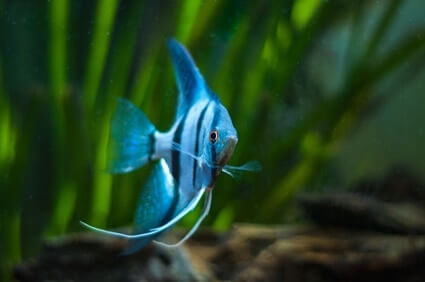
Are Domestic Angelfish Adaptable?
The most rapid changes in the environment occur when there’s human intervention.
Domestic angelfish are some of the most adaptable. This is seen in the aquarium conditions they can tolerate, which their wild varieties can’t.
Angelfish are considered hardy creatures suited to domestic life in aquariums.
They aren’t picky regarding food and can get along with different types of fish. They can even tolerate a range of water parameters, as seen most commonly with freshwater angelfish.
Enthusiasts agree that the most attractive angelfish come from a wilder lineage.
These are more delicate and suffer significantly if the tank conditions aren’t right. Creatures bred domestically adapt to their new conditions better than wild kinds suddenly thrust into captivity.
Angelfish have been bred in captivity since the late 1920s. Of course, this may not seem like a long time for adaptations to occur.
Breeders are already noticing a difference in the physical and behavioral adaptations of the newer pet angelfish generations.
The development of long-lasting adaptations takes roughly a million years. However, it is possible to see changes in a species as early as 100 years.
Angelfish Physical Adaptations
Whether it’s from ancient times or the last 100 years to suit your tank, angelfish have adapted. These new physical traits have helped them to survive and even thrive. They work to:
- Evade predators.
- Hide from danger.
- Drive off competitors.
- Find food.
Let’s explore the physical adaptations found in angelfish today:
Slenderness
An angelfish’s iconic diamond shape gives it many advantages in the wild.
Their form makes them a lot more hydrodynamic. This allows them to cut through the water smoothly at higher speeds, corner quickly, and dart into small spaces.
This feature comes in handy when swimming away from predators. Angelfish use their thin form to hide from larger creatures or other aggressive angelfish.
They can out-swim them and take cover among the plant life in their environment.
Aside from dodging predators, angelfish also eat smaller fish. Their slender form gives them an advantage when chasing their food. If small fish try to hide, angelfish can pull their prey out of the crevices, something that other fish can’t.
Domestic angelfish tend to be more robust than those in the wild. After all, they don’t typically need to be as hydrodynamic and don’t need to hide behind plants as often as their wild counterparts.
They devote their energy to being resilient against illness and unpleasant tank conditions.
Small, Extended Jaws
Angelfish have small, extended jaws and hard teeth.
For species that inhabit coral reefs, their primary food source is sponges. This is uncommon since sponges have a tough exterior. Not many fish can get their nutrition from them.
However, angelfish have jaws ideally suited to chewing on sponges.
Their teeth can bite into the tough exterior. Their extended jaws give them a better grip on the surface, so their shape doesn’t repel them.
Angelfish aren’t very big and can only eat what fits into their mouths.
They don’t have many dining options (not to mention it takes a lot of energy to hunt). They had to adapt to acquire the most plentiful source of food, seas sponges, which comprise 95% of their diet.
Vertical Stripes
The beautiful vertical stripes (tiger stripes) are used to hide among foliage when escaping predators.
The stripes allow them to blend in with the plants better and avoid detection. That’s a trait they often need since they aren’t always the biggest fish in the tank, ocean, or river.
Angelfish bred for tank life have dull stripes because they don’t need to hide from predators very frequently.
Likewise, aquarium plants aren’t usually as vibrant as in freshwater rivers and coral reefs. Since angelfish are so adaptive, the domestic breeds have lighter stripes to match the plants they grow up with.
Mucus Production
Angelfish produce mucus to help shield their bodies and protect their stomach.
For that purpose, they have developed this mucus in 2 ways:
- Angelfish have a thin layer of mucus that covers their scales.
- They also produce mucus in their mouth.
Wild angelfish encounter bacteria and microscopic foreign bodies when swimming through the water. The mucus layer protects them from illness while shielding them from poor water conditions.
The layer in their mouth helps them to eat sea sponges. This food source often tastes bad and irritates the stomach, but angelfish can cover the sponges in mucus before eating them.
This helps with the taste and protects their stomach lining from acidity.
Angelfish Behavior Adaptations
Aside from their physical build, angelfish have also updated their behaviors and personality. This helps them get along with other fish, be cleverer than predators, and protect their offspring.
After all, being a fast swimmer will only go so far if you don’t update your habits to mirror it. Because of this, some of the angelfish’s behavior may seem strange and unnecessary.
Schooling
Angelfish do well in groups of 5+. Schooling behavior is vital in defending them from predators.
Since most hunters can’t track such a gyrating swarm of colors and movement, angelfish are safer in groups. The schooling pattern confuses predators.
Angelfish have strict social hierarchies, which are established through aggression and fighting.
Although it seems unnecessary, it tells each angelfish where it belongs in the school. When it comes time to swim in a carefully ordered pattern, it protects everyone in the group.
Breathing Without Swimming
Unlike most fish species, angelfish can breathe without swimming. This allows them to hide among vegetation for extended periods.
It also means that if vegetation is scarce, they can stay still to avoid detection.
This is effective against a predator that relies on its lateral lines to hunt. If you catch your angelfish staying still for a long time, it’s possibly stressed or frightened.
Color Changes
Angelfish gradually change their color to camouflage and conceal themselves from predators. Avoiding detection is the primary reason for a color change, but angelfish do this subconsciously.
Try adjusting the light conditions in the room where the angelfish tank is located.
You may notice the fish change color within a few minutes or hours. It’s not as stark as an octopus, but it is noticeable.
Angelfish are also dull in color when they sleep. This helps them blend with their environments, so they’re in less danger when they’re not sharply aware.
Filial Cannibalism
When an angelfish pair mates, there’s a high chance they will eat all or half of the eggs. This is true during their first batches when their parental instincts have yet to kick in.
Instead, instinct drives them to eat to have the energy to care for their future offspring.
They would prefer to stay alive for a chance to breed again instead of starving and leaving their offspring vulnerable. Although it’s a non-issue in a well-fed aquarium, these fish retain the drive just in case.
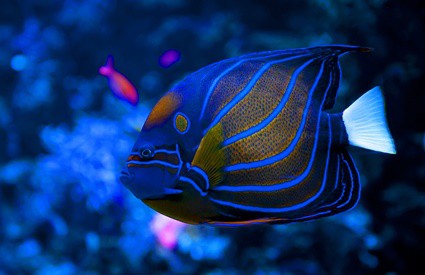
Aggressiveness
As cichlids, angelfish are known to be aggressive and protective of their territory.
They aren’t as vicious as other family members but aren’t afraid to fight. As mentioned, this helps to establish a social hierarchy. It also protects their offspring, territory, and each other.
A female angelfish can lay anywhere between 100 to 1,000 eggs. While this may seem like a lot, it’s a small number compared to fish like the striped bass. They can lay up to 3,000,000 eggs.
Animals that produce fewer offspring are usually more hostile since they must keep as many offspring alive as possible. That’s vital for future reproduction and the continuation of the species.
Mating And Parenting
Angelfish are monogamous and make great parents.
They protect each other as mates and spend hours preparing the area where the fry will hatch. Afterward, the pairs will be highly involved and care for their young until independence.
This trait is an easy way to keep the species alive. Since fry are vulnerable, they would die off without protection from the adults. Although other angelfish may try to eat the fry, the parents keep them at bay.
Angelfish are highly adaptable, taking on physical and behavioral attributes to survive.

